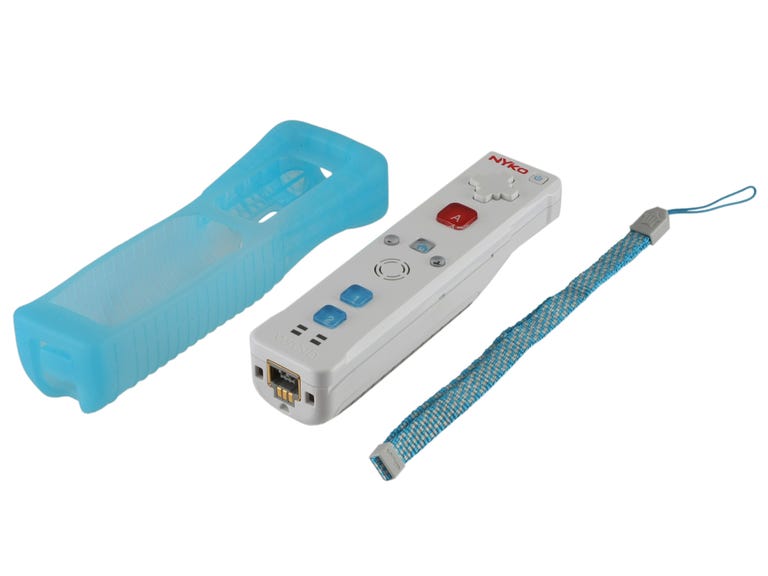Back at CES 2009, a relatively nonexistent gaming presence was rescued by the Nyko Wand, a third-party Wii remote control that promised a complete overhaul of the Nintendo original. Most exciting of all was the device's Trans-Port technology, which allows for button commands to be transferred through the Nunchuk port at the base of the remote. In theory, this essentially eliminates the need for accessories to have moving plastic parts to press buttons on your Wii remote like we saw with the Wii Zapper's trigger and the B button on the Wii remote.
The Good
The Bad
The Bottom Line
Now that Nyko has released the Wand, we're glad to see some of the improvements over the Nintendo Wii remote, but a few design flaws and unanswered operational capabilities dampen the device's potential.
The Wand is almost exactly the same size and shape as a standard Wii remote. There are a few grooves and edges added on the Wand, and the plastic on either side of the D-pad is slightly indented. It's the buttons, inner speaker, and rubberized grip that are different.

Right away you'll notice that Nyko has changed the color, shape, and size of the A, 1, and 2 buttons. It's nice to see larger surface areas here, with the 1 and 2 buttons getting about 50 percent bumps in overall size. All three of these have been given rounded square shapes. The "-" and "+" and buttons remain relatively the same, with the Home button getting the same squared treatment. It's also a few millimeters higher on the body as opposed to inline with the "-" and "+" buttons on the original remote.
The D-pad, on the other hand, is not what we had in mind. It's a bit larger and much more clunky and cumbersome compared with the Nintendo original. While there may be more freedom here to move around, it simply isn't as quick as you need it to be. Using the Wand with Punch-Out!! really displayed the pad's faults. We felt our thumbs needed more of an effort when playing with the Wand. We really would love to have seen the D-pad from the Nyko Wing used here.
Impressively enough, the internal speaker inside the Wand outperforms the one in the Wii remote. Sound effects played through the original are occasionally harsh or distorted. Nyko has clearly made some effort in reducing such undesirables.
Flipping the Wand to the back, we're greeted by a rubberized battery cover, the same one found in either version of the company's Charging Stations (except for the charging contact window). An included rechargeable battery would have been nice here, but Nyko does include two AAs to get you started.
The B trigger has received a slight makeover, too, with vertical rubberized lines added to the curved face of the button. Pressing the trigger is spot-on, requiring very little pressure to engage.

The Wand's claim to fame is certainly its Trans-Port technology, which allows for button commands to be passed through to the remote through its bottom port. This technology will be taken advantage of by specially designed third-party accessories (to be made by Nyko). That said, there aren't any devices available yet that use this. Nyko has promised a Pistol Grip accessory that'll allow for the A and B buttons to be used on the gun's handle, but that isn't scheduled to be available until later this summer. We're not doubting the technology here, it just would have been satisfying to see it in action. Unfortunately, without some hands-on experience, the Trans-Port technology section of this review gets an "I" for incomplete.
There's also some confusion as to whether Wii MotionPlus will be compatible with the Wand. Nyko has told us that Nintendo has not shared any prototypes with the company, so it's essentially impossible to know whether MotionPlus and the Wand will play nicely. We'd have to recommend waiting for our compatibility test results with the two products before purchasing a Wand.
Performance-wise, the Wand acts just like a regular Wii remote. There's no noticeable difference in reaction time, pointing abilities, motion control, or vibration. The standard Nunchuk plugs into the base port with no problems, and there was never an issue of incompatibility. For good measure, Nyko includes a customized wrist strap and blue rubberized covering, to boot.

We're glad to see the Wand is priced similarly to the Wii remote, retailing online for about $30. We wouldn't be able to recommend it had it been priced more expensive. If you're concerned about button size, the Wand has you covered, but the absence of products that support Trans-Port and the uncertainty of MotionPlus compatibility may have you waiting until you pull the trigger on a Nyko Wand. When we do have answers to these questions, we'll be sure to update this review and score accordingly.



